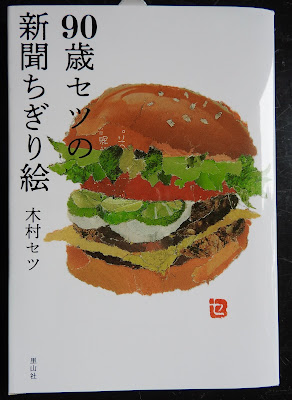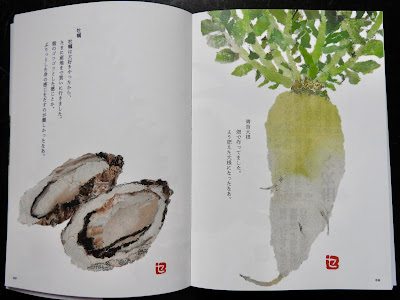目次 / Contents
1) 友人から / From Friend
2) 彼女の人生 / Her Life
3) 作品 / Works
A. ブロッコリー / Broccoli
B. ページ順に / Page Order
4) 最後に / Lastly
1) 友人から / From Friend
先日、久しぶりに友人Sちゃんと長電話をしました。
お互いに近況報告をしました。
彼女がすすめてくれた本『90歳セツの新聞ちぎり絵』をアマゾンで注文し、その本が本日届きました。
ページを開いて驚きました。
素晴らしい!
私は、ちぎり絵のことを詳しく知りませんが、この本のちぎり絵は形の取り方、色の選択などのセンスがよく完成度が高いと感じます。
ですが、絵の魅力は、そういった技術面だけではないのだとも再確認しました。
 |
| 木村 セツ (1929 ~) 里山社 (サトヤマシャ) "Chigiri-e of Newspaper by 90-year-old Setsu" By Setsu Kimura (1929~ )  Cover With Band |
From Friend
A couple days ago, I made a long phone call with my friend S Chan for the first time in a while.
We reported on our lives.
She recommended a book,
"Chigiri-e of Newspaper by 90-year-old Setsu".
I ordered the book from Amazon and it arrived today.
According to Wiki about Chigiri-e,
"Chigiri-e (ちぎり絵) is a Japanese art form in which the primary technique uses coloured paper that is torn to create images, and may resemble a water colour painting.
The technique dates from the Heian period of Japanese history when it was often used in conjunction with calligraphy.
Handmade paper is essential for the creation of chigiri-e images."
I was surprised when I opened the book.
Marvellous!
I don't know much about Chigiri-e, but I feel that the Chigiri-e in this book has a good sense of shape and colour selection and has high degree of perfection.
However, I also reconfirmed that the appeal of pictures is not limited to such skill aspects.
2) 彼女の人生 / Her Life
現在、92歳の松本セツさんのちぎり絵の作品は、お孫さんがTwitter (ツイッター)で紹介したことで人気が出ました。
それがきっかけになり、『90歳セツの新聞ちぎり絵』は、2020年2月に出版され、2021年6月には6回、増刷されています。
私はTVを持っていませんし、SNS (ソーシャル・ネットワーキング・サービス / Social networking service) や Facebook (フェイスブック)、LINE (ライン)、Twitter (ツイッター) もしていません。
一般的な情報や流行とはあまり縁がなく、
『90歳セツの新聞ちぎり絵』の本もSちゃんに教えてもらうまで全く知りませんでした。
セツさんのちぎり絵を見て、人気がある理由はすぐに理解できました。
本には、彼女の人生についても書かれてあります。
彼女の人生は良いことばかりではないけれど、彼女は事柄を受け入れ、前向きに懸命に対処してきたのだと思います。
彼女の包容力にも魅力を感じました。
彼女の人生を前にすると自ずと頭 (コウベ) を垂れる気持ちになります。
本から感じられる、彼女の人柄も人生も、ちぎり絵も、私の心に良い刺激をもたらしました。
 |
| 帯なしの表紙 Cover, Without the Band |
Her Life
Today, 92-year-old Setsu Matsumoto's Chigiri-e work has become popular because her granddaughter introduced it on Twitter.
With that as a trigger, "90-year-old Setsu no Shimbun Chigiri-e" was published in February 2020 and has been reprinted six times to June 2021.
I don't have a TV, and I don't have SNS (Social networking service), Facebook, LINE, or Twitter.
I have nothing to do with general information or trends, and I didn't know anything about "90-year-old Setsu no Shimbun Chigiri-e" until S chan told me.
When I read it and saw Setsu's Chigiri-e, I could immediately understand why it has become so popular.
The book also describes her life.
Her life wasn't all good, but I feel that she accepted the situations and she had adapted positively and worked hard.
I was also fascinated by her tolerance.
When I see her life, I naturally bow my head.
The feelings that I have from the book about her personality, her life, and her Chigiri-e have brought a good stimulus to my heart.
3) 作品 / Works
A. ブロッコリー / Broccoli
どの作品にも心が動かされ、ここで紹介する作品を選ぶのに時間がかかりました。
ちぎり絵は通常、和紙や色紙を使用するようですが彼女は新聞紙を使用します。
新聞紙は彼女の身近にあり、和紙、色紙使用では得られない、'思わぬ効果' を生む素材であるからだと私は理解しました。
(例えば活字が良い効果をあげるなど)
'思わぬ効果' は、私が陶芸作品制作をしている時に、窯もしくは火の効果に感じるものと似ています。
作者は最もよくできた作品は 'ブロッコリー' であると述べています。
その作品は本の裏表紙になり、19ページにも載っています。
'山の景色の写真からみんなとって' (P.18)とあります。
私は、屋久島を訪れ山へ登った時のことを思い出しました。
ガイドのIさんが反対の尾根の山を指差し
「自然林はブロッコリーのように、もりもりしているところだよ。広葉樹の森なんだよ」
と説明してくれたのです。
それは針葉樹ばかりの人が植林した山と比較する説明でした。
セツさんは自然林の山がブロッコリーのようであるということを意識せずに、山の写真を使用しました。
生活の中で養われた観察眼や選択眼が際立って優れていらっしゃるのだと感じます。
I was moved by all the works, and it took me a long time to choose works to introduce here.
Chigiri-e usually uses Washi : Japanese Paper or coloured paper, but she uses newspaper.
I understand that newspaper is familiar to her and produces 'Unexpected Effects' that cannot be obtained by using Japanese paper or coloured paper.
(For example, Japanese printed writing has a good effect.)
Her 'Unexpected Effects' are similar to what I feel when I'm making a ceramic work, the effect of a kiln or fire.
Setsu comments that her best work is 'Broccoli'.
The work is on the back cover of the book and is also on page 19.
She says "Take everypart from the pictures of the mountain scenery" (P.18).
I remembered when I visited Yakushima Island and climbed a mountain.
My guide pointed to the opposite mountain ridge,
"The natural forest is like broccoli, and the woods bulge.
They are all broad-leaved trees.",
he explained.
It was an explanation comparing there with the mountains of coniferous trees planted by people.
Setsu used the pictures of the mountains without being aware that the mountains in the natural forest are like broccoli.
I feel that her observing ability and keen eye for paper that have been cultivated in her daily life are remarkably excellent.
According to Wiki About Yakushima Island,
"Yakushima (屋久島) is one of the Ōsumi Islands in Kagoshima Prefecture, Japan. ~
Yakushima's unique remnant of warm/temperate ancient forest has been a natural World Heritage Site since 1993. "
B. ページ順に / Page Order
私は、ここに載せた作品以外では、、'軍手' (P.44)、'剣先イカ' (P.52-53)、'イガグリ (P.61)、'しめじ' (P.73) が好きです。
...なんとなく渋めが好みなのかも?
明るい色はそれだけで目を惹きがちですが渋めの色で魅力を出す方が実力発揮という気がします....それとも、渋めの好みは、単に私の年のせいでしょうか?(笑)
私は、素材選択のアイディアにも感動します。
夫Rが最も好きなのが、'ひよこ' (P.27) です。
彼が可愛いもの好きなのは知っていましたが、これを選んだ時は
「そう~!」
驚きました。(思っていたよりもずっと可愛いもの好き〜!)
もちろん、彼は他にもたくさん好きな作品はあります。
例えば、' サヤエンドウ' (P.23)、'カツオ' (P.32-33)、 'ほうずき' (P.51)、'金魚鉢' (P.55) など....。
 |
| 'ひよこ' P.27 セツさんは養鶏を生業にしていた時もありました。 'Chicks' There was a time when Setsu was a poultry farmer. P.27 |
Page Order
Other than the works listed here, I like "Gunte : Work Glove" (P.44), "Swordtip Squid" (P.52 - 53), "Igaguri" ; Chestnut in its burr (P.61), and "Shimeji" ; a mushroom (P.73).
... Maybe I like astringency somehow?
Bright colours tend to be eye-catching, but I feel that it is better to make things attractive with astringent colours .... Or is it because of my age? (Laugh)
I am also impressed with her ideas of material selection.
My husband R's most favourite is "Chick" (P.27).
I knew he likes cute things, but when he chose this
"See~!"
I was surprised.
(He likes things that are much more cute than I thought!)
Of course, he likes many other works.
For example, 'Pea' (P.23), 'Bonito' (P.32 - 33), 'Hozuki' (P.51), 'Goldfish Bowl' (P.55), etc ....
 |
| 'ピーマン' / 'Green Pepper' P.50 'ほおずき' / 'Hozuki' : Japanese-lantern P. 51 Japanese traditional writing is vertical and we read from right to left, this book's pages turn from right to left. For example, here on the left : P.51 and on the right : P.50. |
 |
| '牡蠣' (P.89) / 青首大根(P.88) 作品も活字の使われ方もページ構成も好きです。 'Oyster' (P.89) / 'Aokubi Daikon' (P.88) I like the works, the way the printed writings are used, and the page layout. According to MTC KICHEN about Aokubi Daikon, "Aokubi daikon is the most common radish in Japan. Daikon resembles a large, plump white carrot and is high in Potassium and Vitamin C. It is highly versatile when it comes to Japanese cuisine and can be consumed raw, cooked, or pickled." |
4) 最後に / Lastly
この本を買って、本当によかったです。
見ているだけで、心がホコホコしますし、浄化されるように思います。
そうそう、ちぎり絵の作り方も載っていますので、セツさんの技量の素晴らしさも再確認します。
ご興味をもった人にも親切です。
Sちゃん、この本を紹介してくれて、本当にありがとう!
Lastly
I'm really glad I bought this book.
Just looking at the book makes my heart feel warm and purified.
Oh yeah, there is also information on how to make Chigiri-e, so
I could reconfirm the wonderfulness of Setsu's skill.
It is also kind to those who are interested.
Thank you very much for introducing this book, S chan!



0 件のコメント:
コメントを投稿